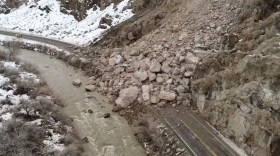It’s been months since the state reported that in 2021, traffic deaths were the worst they’d been since 2006.
But of all recorded types of traffic fatalities, motorcycle deaths increased by 32% — from about 60 people to 79. That was in just one year, from 2020 to 2021, the largest of any other type of vehicle fatality.
What’s behind that?
Peter Vander Aa with the Office of Traffic Safety said they know the pandemic had an effect on people on the roads, but it's unclear why Nevada jumped higher than the rest of the nation.
Impairment by the rider, speeding of all types of vehicles and failing to yield are the top reasons for motorcycle fatalities, he said.
He said to ensure a safer ride, motorcyclists should wear high-visibility attire, motion to make drivers aware of your presence, and some aftermarket products that make headlights blink a little faster.
"Bottom line is anything to make yourself more visible is is going to help," he said.
Erin Breen with UNLV's Transportation Research Center said it falls on the driver: "The largest threat [facing motorcyclists]? Human behavior. Everyone in their own little world and not paying attention and not taking responsibility for their actions."
She said everyone needs to stop and "picture what is 79 people."
"Because if you're just looking at him as a number, it's so easy for you to forget to watch out for them," she said. "Every one of those people left a hole in numerous hearts, and until it happens to you, you won't internalize that. So picture, three classrooms of kids. 79 people, that's a large number of people and we throw these numbers around like they're nothing but each one of them is a huge loss to our community."
Mike Thiel, a Las Vegas police officer, works with the bureau's racing detail.
"We've seen a huge increase of speed in the last 2 years," he said.
He said the only way to describe a serious motorcycle crash is "sheer carnage." A crash that stuck with him, he said, was when a motorcyclist sped away and hit a family in a car that became engulfed in flames. All involved with that crash died.
"We arrived as that happened, and it was the most unheard of scene and it will forever haunt me for what that scene, the sights, the smells, what you heard," Thiel said.
Those clever billboards you see on Nevada's highways? None of today's guests said they like them, because while the messaging is there, it's another distriction for riders, they argued.
In the meantime, Laurie Sanders teaches a motorcycle safety course at the College of Southern Nevada. She said when she started 25 years ago, she lectured, but today it's more interactive.
"We've moved to trying to do activities and present information that helps [students] see the results of bad behavior" on the road.
"If we can internalize that, so that it becomes a value, that safety becomes a value rather than just an ideal, then we have a chance of changing their behaviors," she said.
Laurie Sanders, motorcycle safety instructor, College of Southern Nevada; Erin Breen, director, Road Equity Alliance, University of Nevada, Las Vegas; Mike Thiel, traffic intervention officer, Las Vegas Metropolitan Police; Peter Vander Aa, deputy director,Office of Traffic Safety









